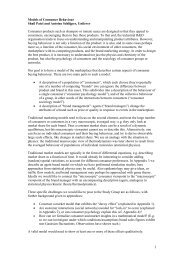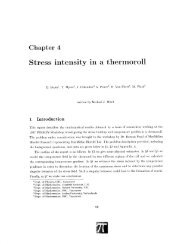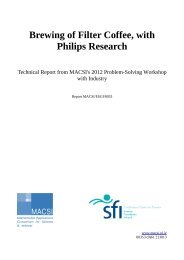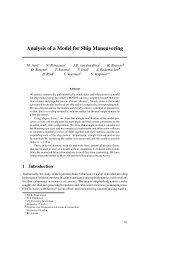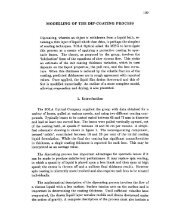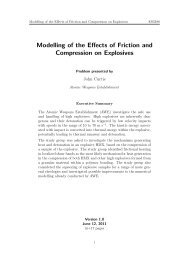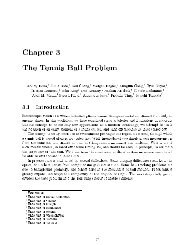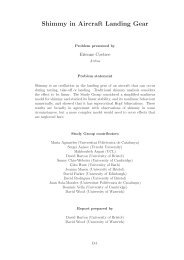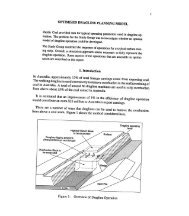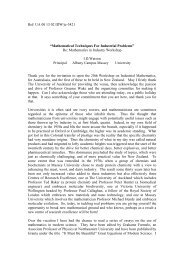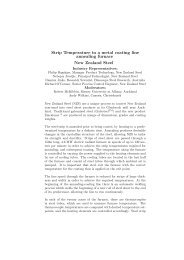Chapter 2 Modelling Quality and Warranty Cost - Mathematics in ...
Chapter 2 Modelling Quality and Warranty Cost - Mathematics in ...
Chapter 2 Modelling Quality and Warranty Cost - Mathematics in ...
You also want an ePaper? Increase the reach of your titles
YUMPU automatically turns print PDFs into web optimized ePapers that Google loves.
J<br />
26 CHAPTER 2. MODELLING QUALITY AND WARRANTY COST<br />
subject to<br />
ê+ FR‚9;A@ FR687:9÷B@C>¸ ê+ SL:9WÆ SL68;= (2.2)<br />
over all admissible 9 . In this project we did not perform this optimization, focus<strong>in</strong>g <strong>in</strong>stead on the<br />
modell<strong>in</strong>g of the function <strong>in</strong>volved.<br />
It is important to note at this juncture that no raw data from Lucent was provided for this project,<br />
nor did we have specific <strong>in</strong>formation about the particular products be<strong>in</strong>g built. It was therefore not<br />
feasible to use exist<strong>in</strong>g hazard/risk models for the various components. Our modell<strong>in</strong>g effort was thus<br />
critically dependent on discussions with the <strong>in</strong>dustrial contact, Prof. Veena Mendiratta. In the section<br />
on future directions we make a series of recommendations which will help ref<strong>in</strong>e the models <strong>in</strong>volved.<br />
We systematically identified the key quality-related attributes, described by a quality vector 9 ,<br />
which could be measured <strong>and</strong> quantified. We then developed reliability, warranty <strong>and</strong> cost models<br />
based on these. As our discussions progressed, it became clear that these quality attributes were not<br />
all <strong>in</strong>dependent. Nor were they all equally important <strong>in</strong>dicators of overall quality. It is thus possible to<br />
simplify the models considerably by focus<strong>in</strong>g on the effects of the most important attributes, mak<strong>in</strong>g<br />
the optimization problem (2.1) simpler to solve. In practice, once cost functions <strong>and</strong> parameters have<br />
been picked on the basis of st<strong>and</strong>ard hazard models, it will be possible via scal<strong>in</strong>g arguments to achieve<br />
further simplification.<br />
With a view to illustrat<strong>in</strong>g qualitative trends predicted by our models, we generated some test data<br />
(see Subsection 2.8), <strong>and</strong> ran our models on them. The graphs presented <strong>in</strong> this report are therefore<br />
not l<strong>in</strong>ked to any true data, <strong>and</strong> serve only to provide qualitative <strong>in</strong>formation.<br />
2.1.1 A Road Map<br />
The follow<strong>in</strong>g list details the strategy for this report. Figure 2.1 illustrates how the various sections of<br />
the report <strong>in</strong>terconnect.<br />
Section 2: In this section we identify the quality-related variables, D , which drive the various<br />
costs associated with a product, <strong>and</strong> over which the optimization will occur. The fact that many<br />
of these variables are not <strong>in</strong>dependent will be dealt with later <strong>in</strong> this report.<br />
Section 3: Here, we develop models for the reliability constra<strong>in</strong>ts, the failure rate FR <strong>and</strong> the<br />
severity levels SL. As well as provid<strong>in</strong>g some graphical <strong>in</strong>sight <strong>in</strong>to the dependence of these<br />
models on the quality D , we also discuss how these failure rates determ<strong>in</strong>e the probability of the<br />
various modes of failure. These probabilities play a role <strong>in</strong> determ<strong>in</strong><strong>in</strong>g the warranty costs of a<br />
product.<br />
Section 4: At this po<strong>in</strong>t <strong>in</strong> the report a model EGFDIH for , the cost of implementation of a given<br />
quality D level is proposed.<br />
Section 5: This conta<strong>in</strong>s the development of the warranty models for J hardware<br />
sw aspects of a product.<br />
hw <strong>and</strong> software<br />
Section 6: Here we comb<strong>in</strong>e the models to summarize the total proposed optimization problem.<br />
Section 7: A sensitivity to parameters is discussed, provid<strong>in</strong>g <strong>in</strong>sight <strong>in</strong>to the relative importance<br />
of terms <strong>in</strong> the various models that have been <strong>in</strong>troduced.



